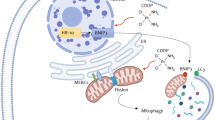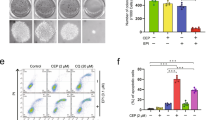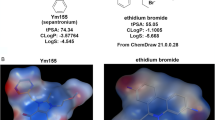Abstract
New chemotherapy-enhancing strategies are needed for better cancer therapy. Previous studies suggest that exogenous cell-permeable C6 ceramide may be a useful adjunct to the anti-tumor effects of chemotherapeutic agents (such as Taxol) against multiple cancers. Here we demonstrate that exogenous cell-permeable C6 ceramide largely sensitizes multiple progressive cancer cell lines to Doxorubicin-induced cell death and apoptosis. We found for the first time that Doxorubicin induces AMP-activated protein kinase (AMPK) activation in a reactive oxygen species-dependent manner. Activation of AMPK contributes to Doxorubicin-induced cancer cell death and apoptosis. Inhibition of AMPK by small interfering RNA knockdown or a pharmacological inhibitor reduces Doxorubicin-induced cancer cell apoptosis, whereas AMPK activator AICAR enhances it. Importantly, we found that C6 ceramide largely enhances Doxorubicin-induced activation of AMPK, which leads to mTOR complex 1 inhibition and chemo-sensitization. Our data suggest that the combination of C6 ceramide with traditional chemotherapy drugs such as Doxorubicin may have the potential to be used as a new therapeutic intervention against multiple cancers.
This is a preview of subscription content, access via your institution
Access options
Subscribe to this journal
Receive 50 print issues and online access
$259.00 per year
only $5.18 per issue
Buy this article
- Purchase on Springer Link
- Instant access to full article PDF
Prices may be subject to local taxes which are calculated during checkout






Similar content being viewed by others
References
Arad M, Seidman CE, Seidman JG . (2007). AMP-activated protein kinase in the heart: role during health and disease. Circ Res 100: 474–488.
Auzenne E, Leroux ME, Hu M, Pollock RE, Feig B, Klostergaard J . (1998). Cytotoxic effects of sphingolipids as single or multi-modality agents on human melanoma and soft tissue sarcoma in vitro. Melanoma Res 8: 227–239.
Bose R, Verheij M, Haimovitz-Friedman A, Scotto K, Fuks Z, Kolesnick R . (1995). Ceramide synthase mediates daunorubicin-induced apoptosis: an alternative mechanism for generating death signals. Cell 82: 405–414.
Cao C, Lu S, Kivlin R, Wallin B, Card E, Bagdasarian A et al. (2008). AMP-activated protein kinase contributes to UV- and H2O2-induced apoptosis in human skin keratinocytes. J Biol Chem 283: 28897–28908.
Carling D . (2004). The AMP-activated protein kinase cascade--a unifying system for energy control. Trends Biochem Sci 29: 18–24.
Chiang PC, Lin SC, Pan SL, Kuo CH, Tsai IL, Kuo MT et al. (2010). Antroquinonol displays anticancer potential against human hepatocellular carcinoma cells: a crucial role of AMPK and mTOR pathways. Biochem Pharmacol 79: 162–171.
Grunwald V, DeGraffenried L, Russel D, Friedrichs WE, Ray RB, Hidalgo M . (2002). Inhibitors of mTOR reverse doxorubicin resistance conferred by PTEN status in prostate cancer cells. Cancer Res 62: 6141–6145.
Hortobagyi GN . (1997). Anthracyclines in the treatment of cancer. An overview. Drugs 54 (Suppl 4): 1–7.
Inoki K, Ouyang H, Zhu T, Lindvall C, Wang Y, Zhang X et al. (2006). TSC2 integrates Wnt and energy signals via a coordinated phosphorylation by AMPK and GSK3 to regulate cell growth. Cell 126: 955–968.
Inoki K, Zhu T, Guan KL . (2003). TSC2 mediates cellular energy response to control cell growth and survival. Cell 115: 577–590.
Jaswal JS, Gandhi M, Finegan BA, Dyck JR, Clanachan AS . (2006). Effects of adenosine on myocardial glucose and palmitate metabolism after transient ischemia: role of 5′-AMP-activated protein kinase. Am J Physiol Heart Circ Physiol 291: H1883–H1892.
Jones RG, Plas DR, Kubek S, Buzzai M, Mu J, Xu Y et al. (2005). AMP-activated protein kinase induces a p53-dependent metabolic checkpoint. Mol Cell 18: 283–293.
Jung SN, Yang WK, Kim J, Kim HS, Kim EJ, Yun H et al. (2008). Reactive oxygen species stabilize hypoxia-inducible factor-1 alpha protein and stimulate transcriptional activity via AMP-activated protein kinase in DU145 human prostate cancer cells. Carcinogenesis 29: 713–721.
Kahn BB, Alquier T, Carling D, Hardie DG . (2005). AMP-activated protein kinase: ancient energy gauge provides clues to modern understanding of metabolism. Cell Metab 1: 15–25.
Kim do Y, Park MW, Yuan HD, Lee HJ, Kim SH, Chung SH . (2009). Compound K induces apoptosis via CAMK-IV/AMPK pathways in HT-29 colon cancer cells. J Agric Food Chem 57: 10573–10578.
Kolesnick RN, Kronke M . (1998). Regulation of ceramide production and apoptosis. Annu Rev Physiol 60: 643–665.
Mehta S, Blackinton D, Omar I, Kouttab N, Myrick D, Klostergaard J et al. (2000). Combined cytotoxic action of paclitaxel and ceramide against the human Tu138 head and neck squamous carcinoma cell line. Cancer Chemother Pharmacol 46: 85–92.
Morgillo F, Woo JK, Kim ES, Hong WK, Lee HY . (2006). Heterodimerization of insulin-like growth factor receptor/epidermal growth factor receptor and induction of survivin expression counteract the antitumor action of erlotinib. Cancer Res 66: 10100–10111.
Nithipongvanitch R, Ittarat W, Cole MP, Tangpong J, Clair DK, Oberley TD . (2007). Mitochondrial and nuclear p53 localization in cardiomyocytes: redox modulation by doxorubicin (Adriamycin)? Antioxid Redox Signal 9: 1001–1008.
Okoshi R, Ozaki T, Yamamoto H, Ando K, Koida N, Ono S et al. (2007). Activation of AMP-activated protein kinase induces p53-dependent apoptotic cell death in response to energetic stress. J Biol Chem 283: 3979–3987.
Piguet AC, Semela D, Keogh A, Wilkens L, Stroka D, Stoupis C et al. (2008). Inhibition of mTOR in combination with doxorubicin in an experimental model of hepatocellular carcinoma. J Hepatol 49: 78–87.
Qiu L, Zhou C, Sun Y, Di W, Scheffler E, Healey S et al. (2006). Paclitaxel and ceramide synergistically induce cell death with transient activation of EGFR and ERK pathway in pancreatic cancer cel. Oncol Rep 16: 907–913.
Radin NS . (2003). Killing tumours by ceramide-induced apoptosis: a critique of available drugs. Biochem J 371: 243–256.
Rath G, Schneider C, Langlois B, Sartelet H, Morjani H, Btaouri HE et al. (2009). De novo ceramide synthesis is responsible for the anti-tumor properties of camptothecin and doxorubicin in follicular thyroid carcinoma. Int J Biochem Cell Biol 41: 1165–1172.
Ravid A, Rocker D, Machlenkin A, Rotem C, Hochman A, Kessler-Icekson G et al. (1999). 1,25-Dihydroxyvitamin D3 enhances the susceptibility of breast cancer cells to doxorubicin-induced oxidative damage. Cancer Res 59: 862–867.
Romano MF, Avellino R, Petrella A, Bisogni R, Romano S, Venuta S . (2004). Rapamycin inhibits doxorubicin-induced NF-kappaB/Rel nuclear activity and enhances the apoptosis of melanoma cells. Eur J Cancer 40: 2829–2836.
Ruderman NB, Keller C, Richard AM, Saha AK, Luo Z, Xiang X et al. (2006). Interleukin-6 regulation of AMP-activated protein kinase. Potential role in the systemic response to exercise and prevention of the metabolic syndrome. Diabetes 55 (Suppl 2): S48–S54.
Steinberg GR, Kemp BE . (2009). AMPK in health and disease. Physiol Rev 89: 1025–1078.
Towler MC, Hardie DG . (2007). AMP-activated protein kinase in metabolic control and insulin signaling. Circ Res 100: 328–341.
Yamauchi M, Kambe F, Cao X, Lu X, Kozaki Y, Oiso Y et al. (2008). Thyroid hormone activates adenosine 5′-monophosphate-activated protein kinase via intracellular calcium mobilization and activation of calcium/calmodulin-dependent protein kinase kinase-beta. Mol Endocrinol 22: 893–903.
Yoon H, Oh YT, Lee JY, Choi JH, Lee JH, Baik HH et al. (2008). Activation of AMP-activated protein kinase by kainic acid mediates brain-derived neurotrophic factor expression through a NF-kappaB dependent mechanism in C6 glioma cells. Biochem Biophys Res Commun 371: 495–500.
Yoon MJ, Lee GY, Chung JJ, Ahn YH, Hong SH, Kim JB . (2006). Adiponectin increases fatty acid oxidation in skeletal muscle cells by sequential activation of AMP-activated protein kinase, p38 mitogen-activated protein kinase, and peroxisome proliferator-activated receptor alpha. Diabetes 55: 2562–2570.
Zhang JF, Liu JJ, Lu MQ, Cai CJ, Yang Y, Li H et al. (2007). Rapamycin inhibits cell growth by induction of apoptosis on hepatocellular carcinoma cells in vitro. Transpl Immunol 17: 162–168.
Zhu W, Soonpaa MH, Chen H, Shen W, Payne RM, Liechty EA et al. (2009). Acute doxorubicin cardiotoxicity is associated with p53-induced inhibition of the mammalian target of rapamycin pathway. Circulation 119: 99–106.
Acknowledgements
This research was supported in part by grants from the National Natural Science Foundation of China (30271195 and 30671894).
Author information
Authors and Affiliations
Corresponding authors
Ethics declarations
Competing interests
The authors declare no conflict of interest.
Additional information
Supplementary Information accompanies the paper on the Oncogene website
Rights and permissions
About this article
Cite this article
Ji, C., Yang, B., Yang, YL. et al. Exogenous cell-permeable C6 ceramide sensitizes multiple cancer cell lines to Doxorubicin-induced apoptosis by promoting AMPK activation and mTORC1 inhibition. Oncogene 29, 6557–6568 (2010). https://doi.org/10.1038/onc.2010.379
Received:
Revised:
Accepted:
Published:
Issue Date:
DOI: https://doi.org/10.1038/onc.2010.379
Keywords
This article is cited by
-
Tremella fuciformis polysaccharides alleviates UV-provoked skin cell damage via regulation of thioredoxin interacting protein and thioredoxin reductase 2
Photochemical & Photobiological Sciences (2023)
-
Targeting sphingosine kinase 1/2 by a novel dual inhibitor SKI-349 suppresses non-small cell lung cancer cell growth
Cell Death & Disease (2022)
-
Melatonin and doxorubicin synergistically enhance apoptosis via autophagy-dependent reduction of AMPKα1 transcription in human breast cancer cells
Experimental & Molecular Medicine (2021)
-
Bitter apricot ethanolic extract induces apoptosis through increasing expression of Bax/Bcl-2 ratio and caspase-3 in PANC-1 pancreatic cancer cells
Molecular Biology Reports (2020)
-
Investigation of the tumoricidal effects of sonodynamic therapy in malignant glioblastoma brain tumors
Journal of Neuro-Oncology (2020)



